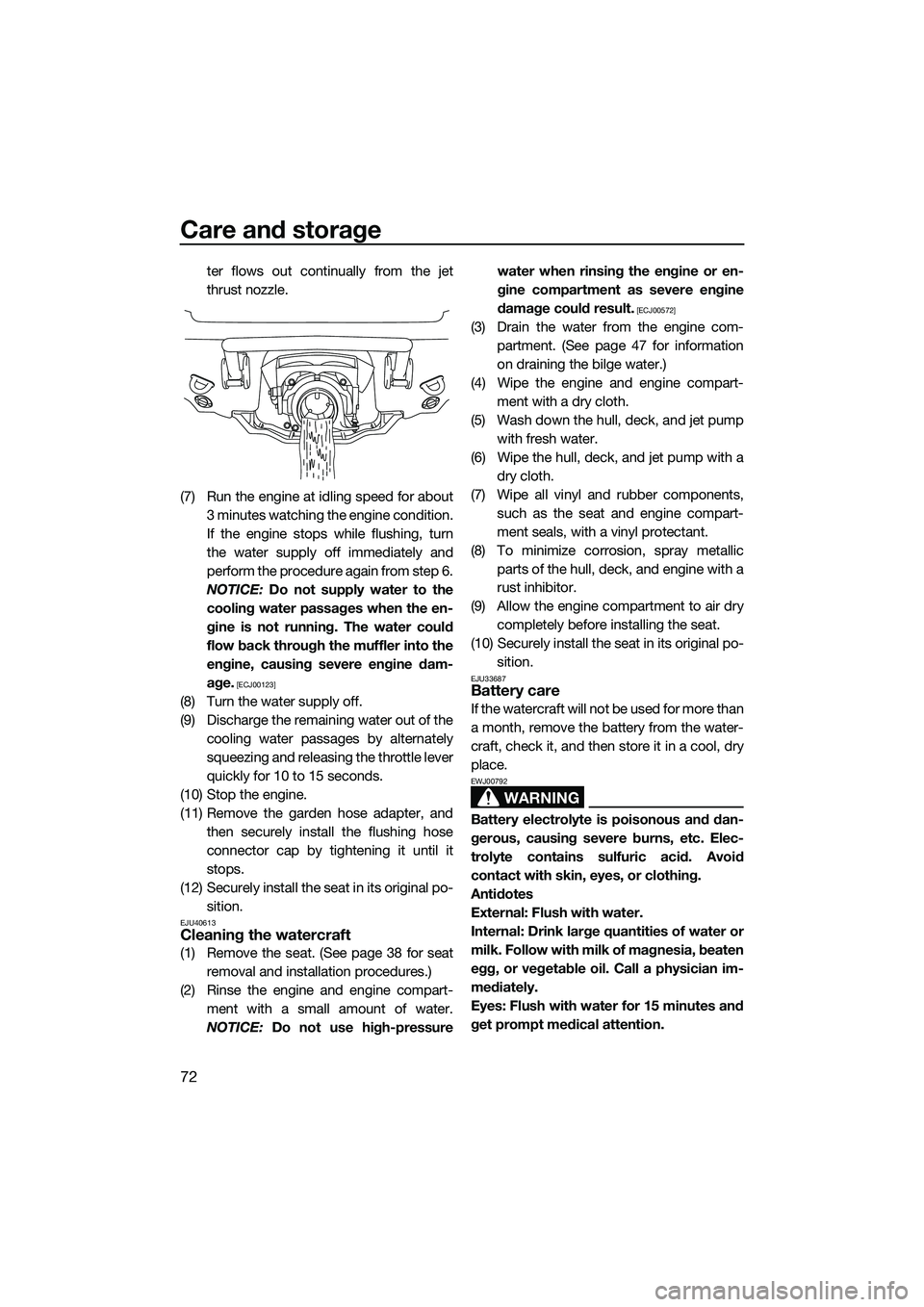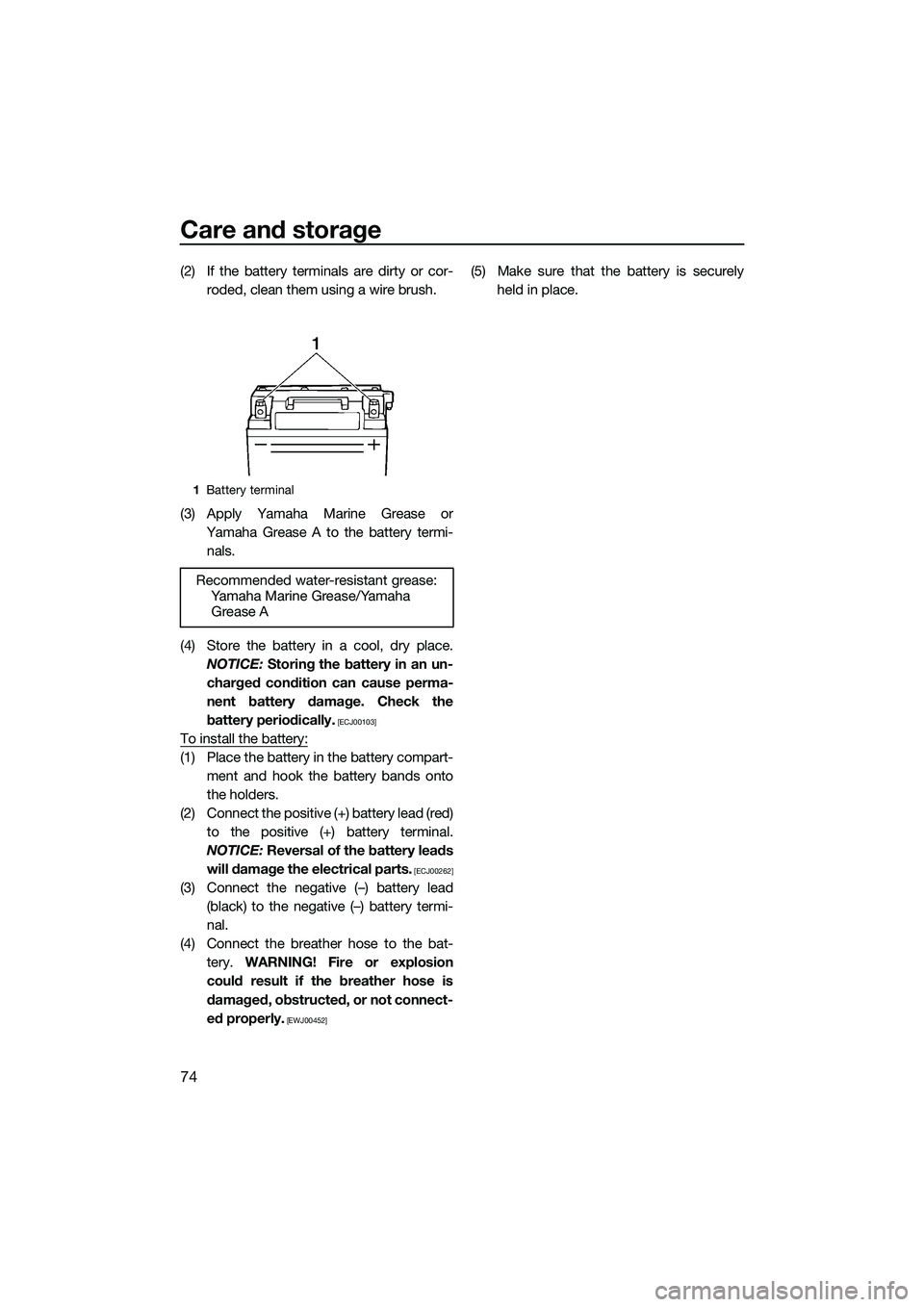ECU YAMAHA VXR 2014 Owner's Guide
[x] Cancel search | Manufacturer: YAMAHA, Model Year: 2014, Model line: VXR, Model: YAMAHA VXR 2014Pages: 98, PDF Size: 3.98 MB
Page 78 of 98

Care and storage
72
ter flows out continually from the jet
thrust nozzle.
(7) Run the engine at idling speed for about 3 minutes watching the engine condition.
If the engine stops while flushing, turn
the water supply off immediately and
perform the procedure again from step 6.
NOTICE: Do not supply water to the
cooling water passages when the en-
gine is not running. The water could
flow back through the muffler into the
engine, causing severe engine dam-
age.
[ECJ00123]
(8) Turn the water supply off.
(9) Discharge the remaining water out of the cooling water passages by alternately
squeezing and releasing the throttle lever
quickly for 10 to 15 seconds.
(10) Stop the engine.
(11) Remove the garden hose adapter, and then securely install the flushing hose
connector cap by tightening it until it
stops.
(12) Securely install the seat in its original po- sition.
EJU40613Cleaning the watercraft
(1) Remove the seat. (See page 38 for seatremoval and installation procedures.)
(2) Rinse the engine and engine compart- ment with a small amount of water.
NOTICE: Do not use high-pressure water when rinsing the engine or en-
gine compartment as severe engine
damage could result.
[ECJ00572]
(3) Drain the water from the engine com-
partment. (See page 47 for information
on draining the bilge water.)
(4) Wipe the engine and engine compart- ment with a dry cloth.
(5) Wash down the hull, deck, and jet pump with fresh water.
(6) Wipe the hull, deck, and jet pump with a dry cloth.
(7) Wipe all vinyl and rubber components, such as the seat and engine compart-
ment seals, with a vinyl protectant.
(8) To minimize corrosion, spray metallic parts of the hull, deck, and engine with a
rust inhibitor.
(9) Allow the engine compartment to air dry completely before installing the seat.
(10) Securely install the seat in its original po- sition.
EJU33687Battery care
If the watercraft will not be used for more than
a month, remove the battery from the water-
craft, check it, and then store it in a cool, dry
place.
WARNING
EWJ00792
Battery electrolyte is poisonous and dan-
gerous, causing severe burns, etc. Elec-
trolyte contains sulfuric acid. Avoid
contact with skin, eyes, or clothing.
Antidotes
External: Flush with water.
Internal: Drink large quantities of water or
milk. Follow with milk of magnesia, beaten
egg, or vegetable oil. Call a physician im-
mediately.
Eyes: Flush with water for 15 minutes and
get prompt medical attention.
UF2M73E0.book Page 72 Friday, August 2, 2013 11:28 AM
Page 80 of 98

Care and storage
74
(2) If the battery terminals are dirty or cor-roded, clean them using a wire brush.
(3) Apply Yamaha Marine Grease or Yamaha Grease A to the battery termi-nals.
(4) Store the battery in a cool, dry place. NOTICE: Storing the battery in an un-
charged condition can cause perma-
nent battery damage. Check the
battery periodically.
[ECJ00103]
To install the battery:
(1) Place the battery in the battery compart- ment and hook the battery bands onto
the holders.
(2) Connect the positive (+) battery lead (red) to the positive (+) battery terminal.
NOTICE: Reversal of the battery leads
will damage the electrical parts.
[ECJ00262]
(3) Connect the negative (–) battery lead (black) to the negative (–) battery termi-
nal.
(4) Connect the breather hose to the bat- tery. WARNING! Fire or explosion
could result if the breather hose is
damaged, obstructed, or not connect-
ed properly.
[EWJ00452]
(5) Make sure that the battery is securely held in place.
1Battery terminal
Recommended water-resistant grease:
Yamaha Marine Grease/Yamaha
Grease A
UF2M73E0.book Page 74 Friday, August 2, 2013 11:28 AM
Page 84 of 98

Maintenance
78
(3) Lift up the engine cover and remove it.
To install the engine cover:
(1) Place the engine cover in its original po-sition, and then push it down.
(2) Install the engine cover screws, and then tighten them to the specified torque.
(3) Securely install the seat in its original po- sition.
1Engine cover
Tightening torque:
Engine cover screw:
4.5 Nm (0.46 kgf-m, 3.3 ft-lb)
1
UF2M73E0.book Page 78 Friday, August 2, 2013 11:28 AM
Page 93 of 98

Trouble recovery
87
(2) Remove the electrical box cover.
(3) Loosen the cap on the electrical box andremove it.
(4) Replace the blown fuse with the spare fuse of the correct amperage by using
the fuse puller on the reverse side of the
cap. WARNING! Do not use fuses of a
different amperage than recommend-
ed. Substitution with a fuse that has
an improper rating can cause exten- sive electrical system damage and
possible fire.
[EWJ00803]
(5) Securely install the cap by tightening it
until it stops.
(6) Securely install the electrical box cover in its original position.
1Electrical box cover
1
1Electrical box
2 Spare fuse
3 Fuse
4 Cap
1 Fuse puller
Fuse amperage:
Battery fuse: 30 A
Main relay drive fuse: 10 A
Electronic throttle valve fuse:
10 A
Security system fuse: 3 A
Main fuse: 20 A
1
2
4
3
UF2M73E0.book Page 87 Friday, August 2, 2013 11:28 AM
Page 94 of 98

Trouble recovery
88
(7) Securely install the seat in its original po-sition.
If the fuse immediately blows again, the elec-
trical system may be defective. If this occurs,
have a Yamaha dealer service the watercraft.
EJU34716Towing the watercraft
WARNING
EWJ00812
The operator of the towing boat must
keep speed to a minimum and avoid
traffic or obstacles which could be a
hazard to the operator on the water-
craft.
The towline should be long enough so
that the watercraft will not collide with
the towing boat when slowing down.
If the watercraft becomes inoperative in the
water, it can be towed to shore.
To tow the watercraft:
Use a towline that is three times the com-
bined length of the towing boat and the wa-
tercraft.
(1) Securely attach the towline to the bow eye of the watercraft being towed.
(2) Sit astride the seat and hold on to the handlebars in order to balance the water-
craft. NOTICE: The bow must be kept
up out of the water during towing, oth-
erwise water could flood the engine compartment or water could flow
back into the engine, causing severe
engine damage.
[ECJ01331]
Tow the watercraft at 8 km/h (5 mph) or less.
NOTICE: Tow the watercraft at 8 km/h (5
mph) or less, otherwise water could flood
the engine compartment or water could
flow back into the engine, causing severe
engine damage.
[ECJ01322]
EJU36156
Submerged watercraft
If the watercraft is submerged or flooded with
water, drain the bilge water from the engine
compartment. Then, have a Yamaha dealer
service the watercraft as soon as possible.
If the watercraft was submerged:
(1) Remove the watercraft from the water and drain the water from the storage
compartments. (See page 40 for infor-
mation on draining the storage compart-
ments.)
(2) Drain the bilge water from the engine compartment. (See page 47 for informa-
tion on draining the bilge water.)
(3) Have the watercraft serviced by a Yamaha dealer as soon as possible.
NOTICE: Be sure to have a Yamaha
dealer inspect the watercraft. Other-
wise, serious engine damage could
result.
[ECJ00792]
1 Bow eye
1
UF2M73E0.book Page 88 Friday, August 2, 2013 11:28 AM
Page 96 of 98

Index
M
Main components, location of ................. 21
Maintenance ............................................ 77
Manufactured date label ............................ 2
Model information ...................................... 2
Multifunction information center .............. 33
Multifunction information center check ... 58
O
Oil pressure warning ................................ 36
Operating in weeded areas ...................... 70
Operating the watercraft .......................... 62
Operating the watercraft in reverse ......... 64
Operating your watercraft ........................ 59
Operation requirements ........................... 12
P
Periodic maintenance chart ..................... 79
Post-launch checks ................................. 58
Post-operation care ................................. 71
Pre-launch checks ................................... 52
Pre-operation check points ..................... 52
Pre-operation checklist ............................ 50
Primary Identification (PRI-ID) number ...... 1
R
Reboarding step (VXR) ............................. 39
Recommended equipment ...................... 14
Remote control transmitter ...................... 25
Remote control transmitter check ........... 55
Reverse system........................................ 30
Reverse system checks ........................... 54
Riding position ......................................... 60
Rustproofing ............................................ 76
S
Safe boating rules .................................... 18
Safety equipment check .......................... 57
Seat .......................................................... 38
Speedometer ........................................... 33
Start switch .............................................. 27
Starting off ............................................... 67
Starting off from a trailer .......................... 68
Starting the engine on water .................... 60
Steering system ....................................... 28
Steering system checks ........................... 53
Stern drain plug checks ........................... 57
Stern eyes ................................................ 40
Stopping the engine ................................. 61Stopping the watercraft ........................... 63
Storage compartment checks.................. 56
Storage compartments ............................ 40
Submerged watercraft ............................. 88
Switch checks .......................................... 56
T
Tachometer .............................................. 34
Throttle lever ............................................ 28
Throttle lever checks ................................ 55
Tool kit ..................................................... 77
Towing the watercraft .............................. 88
Transporting on a trailer ........................... 48
Troubleshooting ....................................... 82
Troubleshooting chart .............................. 82
Turning the watercraft .............................. 62
W
Water separator ....................................... 29
Water separator check ............................. 52
Watercraft characteristics ........................ 15
Watercraft control functions..................... 25
Watercraft operation functions ................ 30
Watercraft operation modes .................... 31
Water-skiing ............................................. 17
Y
Yamaha Security System ......................... 26
Yamaha Security System settings ........... 26
UF2M73E0.book Page 2 Friday, August 2, 2013 11:28 AM